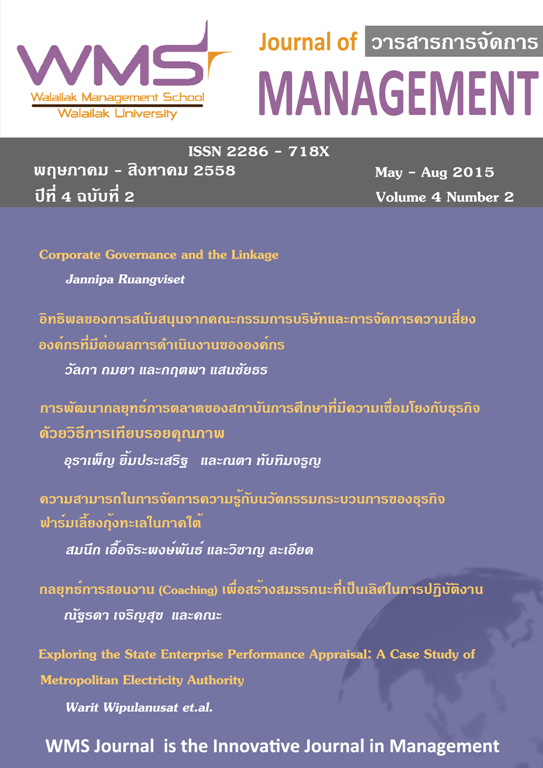Corporate Governance and the Linkage
Main Article Content
Abstract
Article Details
References
Ball, R. and Brown, P. 1968. An Empirical Evaluation of Accounting Income Numbers. Journal of Accounting Research. 6: 159-178.
Brown, S. and Warner, J. 1980. Measuring security price performance: The case of event studies. Journal of Financial Economics. 14: 1-51.
Brown, S. and Warner, J. 1985. Using Daily Stock Returns: The case of event studies. Journal of Financial Economics. 14: 3-31.
Bruner, R.F. 1999. An analysis of value destruction and recovery in the alliance and proposed merger of Volvo and Renault. Journal of Financial Economics. 51: 125-166.
Cooper, D. and Woglom, G. 2003. The S&P 500 Effect: Not So Good in the Long Run. Journal of Investing. 12(4): 62-73.
Cremers, K.J. and Nair V.B. 2005. Governance mechanisms and equity prices. Journal of Finance, 60(6): 2859-2894.
Durnev, A. and Kim, E.H. 2005. To steal or not to steal: firm attributes, legal environment, and valuation. Journal of Finance. 60: 1461–1493.
Edmister, R., Graham, S. and Pirie, W. 1994. Excess Returns of Index Replacement Stocks: Evidence of Liquidity and Substitutability. Journal of Financial Research. 17: 333-346.
Ergin, E. 2012. Corporate Governance Ratings and Market Based Financial Performance: Evidence from Turkey. International Journal of Economics and Finance. 4(9): 61-68.
Gawer, J. 2009. Does It Pay to Improve Corporate Governance? An Empirical Analysis of European Equities. Http://www.unpri.org/files/Gawer_PRI2009.pdf.
Gompers, P. Ishii, L. and Metrick A. 2003. Corporate governance and equity prices. Quarterly Journal of Economics, 118(1): 107-155.
Gregory, A. 1997. An Examination of the Long Run Performance of UK Acquiring Firms. Journal of Business Finance and Accounting. 24: 971-1002.
Hertzel, M., Lemmon, M., Linck, J.S. and Rees, L. 2002. Long-Run Performance following Private Placements of Equity. Journal of Finance. 57: 2595-2617.
Harris, L. and Gurel E. 1986. Price and Volume Effects Associated with Changes in the S&P 500 List: New Evidence for the Existence of Price Pressures. Journal of Finance. 41: 815-829.
Klapper, L.F. and Love, I. 2002. Corporate governance, investor protection and performance in emerging markets. WorldBank Policy Research. Working Paper, No. 2818.
Kouwenberg R. and Visit Phunnarungsi. 2013. Corporate governance, violations and market reactions. Pacific-Basin Finance Journal. 21: 881-898.
Liu, S. 2001. Changes in the Nikkei 500: New Evidence for Downward-Sloping Demand Curves for Stocks. International Review of Finance. 1: 245-267.
Lummer, S. L. and Mcconnell, J.J. 1989. Further Evidence on the Bank Lending Process and the Capital-Market Response to Bank Loan Agreements. Journal of Financial Economics. 25: 99-122.
Lynch, A. and Mendenhall, R. 1997. New Evidence on Stock Price Effects Associated with Change in the SandP 500 Index. Journal of Business. 70(3): 351-383.
Piman Limpaphayom. and Connelly, J. T. 2004. Corporate Governance in Thailand. http://dx.doi.org/10.2139/ssrn.965300.
Sawicki, J. 2009. Corporate governance and dividend policy in Southeast Asia pre- and post-crisis. European Journal of Finance. 15: 211-230.
Scholes, M. S. 1972. The Market for Securities: Substitute Versus Price Pressure and the Effects of Information on Share Prices. The Journal of Business. 45(2): 179-211.
Small, K., Iomci, O. and Zhu, H. 2007. Size Does Matter: An Examination of the Economic Impact of Sarbanes-Oxley. Review of Business. 27: 47-55.
Teker, S. and Yuksel, A.H. 2014. Stock Price Reaction for Scoring on Corporate Governance. Procedia – Social and Behavioral Sciences. 150: 985-992.
Thitima Sitthipongpanich. 2011. Understanding the Event Study. Journal of Business Administration. 34 (130): 60-68.


